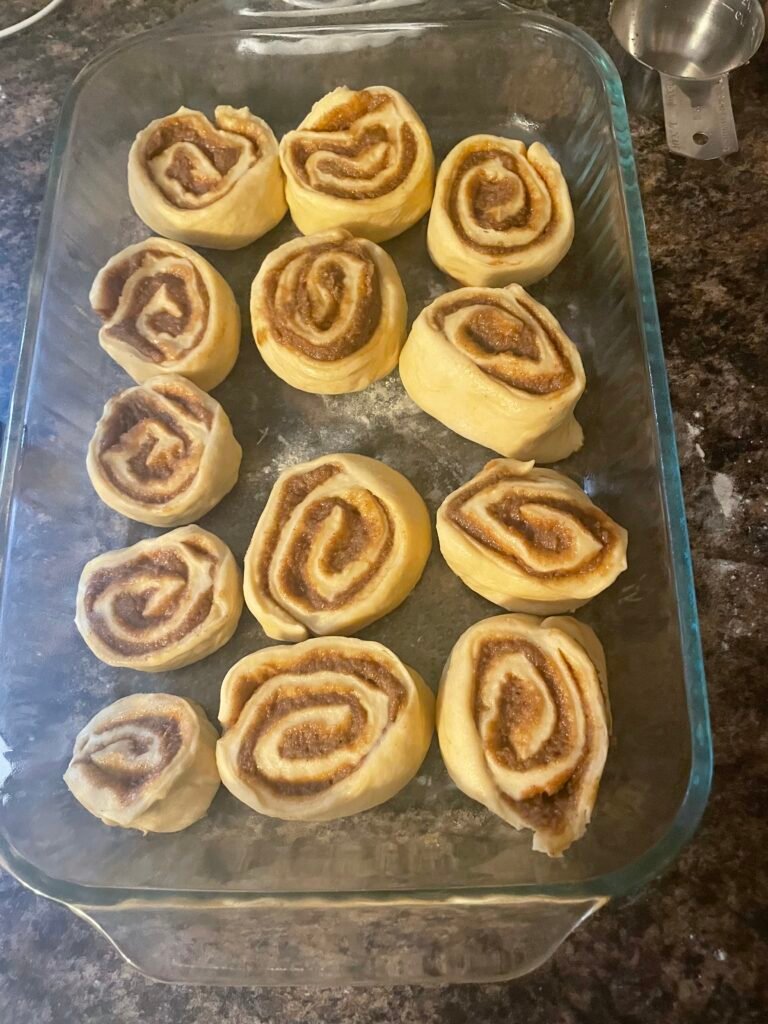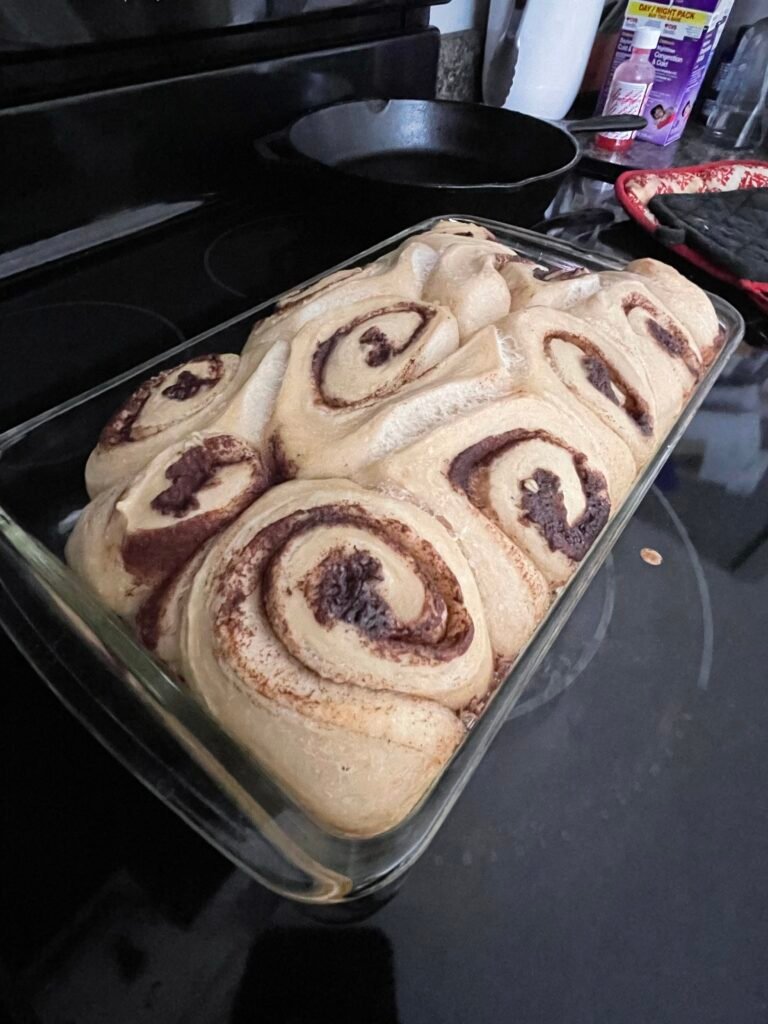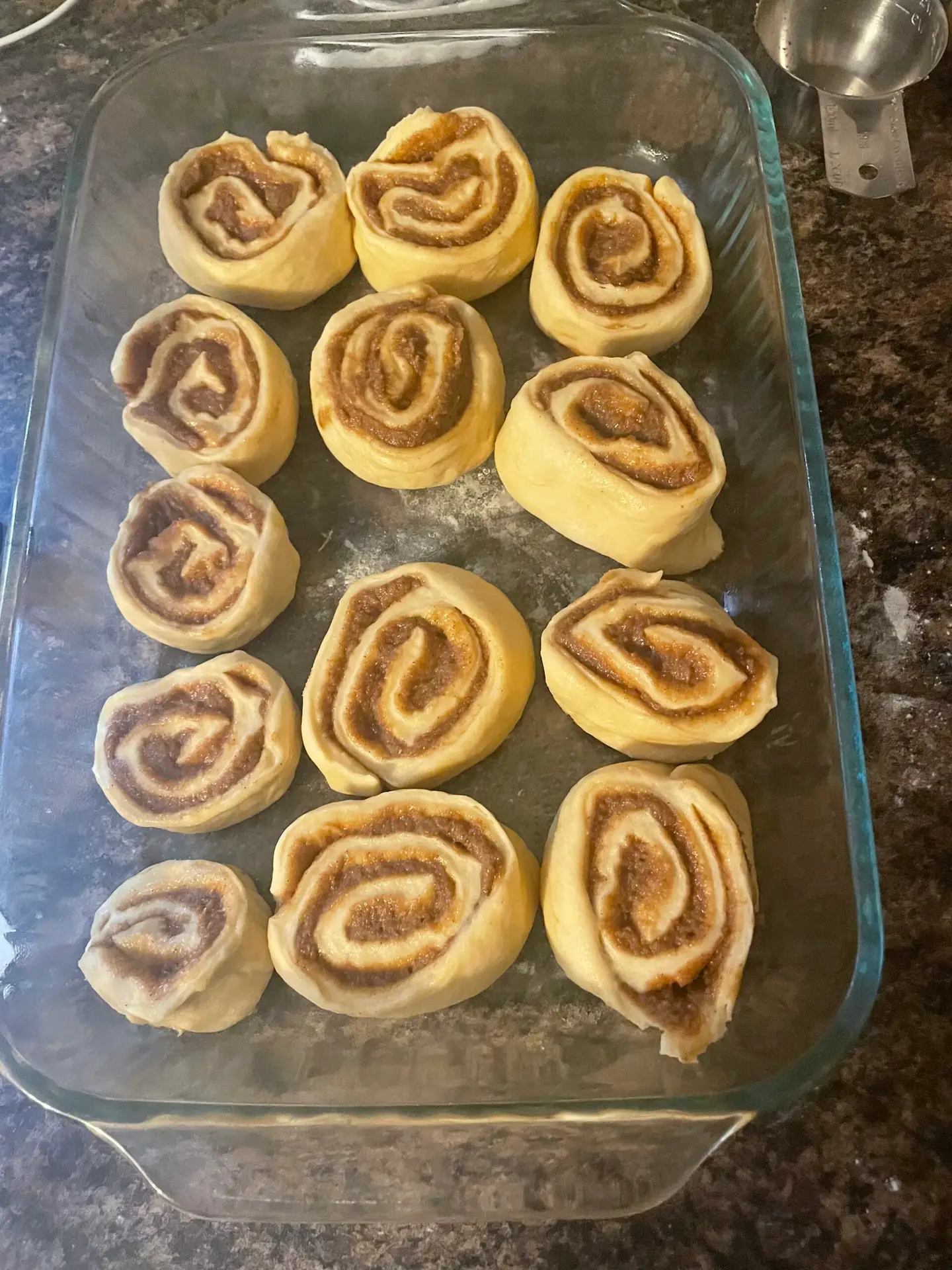The way to my family’s heart is through their stomach. Or, is my love language expression baking? I’m not sure. Regardless, my family loves these cinnamon rolls. I’ve made them with both the cream cheese frosting and powdered sugar icing. This recipe below only has the powdered sugar icing recipe. One day, I’ll get around to adding the cream cheese frosting recipe.

Why bake Sourdough Cinnamon Rolls?
Have you ever noticed, there’s usually only one brand of cinnamon rolls sold (pre-made) at the grocery store? it’s the same company that makes biscuits, crescents, and pie crusts. And, they’re sold in packs of 5! Like, who eats just 5 cinnamon rolls?! Not this family. This recipe will bless you with at least a dozen, and if stored well they will keep for almost a week. I prefer this over the store bought simply because everything tastes better when it’s homemade. The time and attention you put into making these makes the reward that much … sweeter.
There's a history of cinnamon rolls!?
In my quest to find the best recipe, I discovered the cinnamon roll’s history is rooted in Northern Europe, particularly Sweden and Germany, with the modern version emerging in the 1920s.
According to the Cadbury Dessert Corner, the first version resembling today’s version of a cinnamon roll, likely originated in Greece. Bakers combined cinnamon and honey infused dough to craft a treat imbued with sweetness and enticing aroma. This sugary indulgence was believed to have been savored by the elite while also being offered as a devotional gift to “divine entities.”
We know cinnamon, the crucial ingredient here, became more readily available in Europe during the Age of Exploration. With industrialization, the 20th century witnessed transformation of food — and not always to the benefit of the consumer (a rabbit hole I could be swallowed into today, but I’ll avoid it). Swedish immigrants brought their “Kanelbulle” recipes to the U.S., where they evolved into the popular American cinnamon roll.
With the introduction of pre-made, refrigerated dough, coupled with the emergence of fast-food chains and supermarkets – cinnamon rolls have become easily accessible across the U.S.
But, I believe there’s hidden costs associated with modern day conveniences. Surlely, indulging in a cinnamon roll isn’t the end of your healthy lifestyle. My greater point is that we should be more aware of what’s in our foods – especially the ones that are super “convenient.”
Health Benefits of Cinnamon
When you think about cinnamon rolls, you probably don’t think, “Whoah, this is super healthy.” AND that’s ok! I believe you can enjoy sweets in moderation. BUT, if it makes you feel better, there are some health benefits. Cinnamon has unique antioxidant properties that have led to its being used in food preservation. There’s also evidence that cinnamon is anti-inflammatory.
Cinnamon is also good for the blood. Some evidence suggests it can lead to a reduction in heart disease. This is really good news since heart disease is a major killer across the world.
Enjoy this in moderation, of course — because too much of a good thing can be a bad thing.
Getting on with the baking of cinnamon rolls

But, you’re not here necessarily to hear about my theory of modern day convenience foods.
If you’re here, it’s because you’re taking an active step in managing your food! I commend you! Baking is no easy feat and this recipe, as simple as it may sound, has a lot of steps and that can be confusing for some. Please do not let it deter you.
YOU CAN DO THIS!
YOU CAN MAKE HOMEMADE CINNAMON ROLLS
There’s no reason why you shouldn’t be able to make these from home. So long as you have sourdough, a spoon, cinnamon and a baking pan — I have full faith in you.

Let’s bake. Slow down. And, share something sweet — together.
If you tried this recipe, please leave a comment to let me know how you LOVED it!

Homemade sourdough cinnamon rolls
Ingredients
- 150 grams Sourdough discard (freshly fed and active) (2/3 Cups)
- 325 grams Warm water (1 1/3 cups)
- 25 grams Honey (1 1/2 tablespoons) I like to oil my measuring spoon to make easier
- 20 grams Avocado oil (you want to use a flavorless oil) (1 Tablespoon)
- 500 grams White bread flour (4 Cups) I've used all purpose and bread flour. The bread flour definitely gave this more "fluff"
- 10 grams Salt (1/2 Tablespoon) I've forgotten the salt before and it was noticeable.
- 78 grams Melted Butter (1/3 Cup) You'll want to cover your dough evenly
- 16 grams Cinnamon (~2 Tablespoons)
- 99 grams Sugar (1/2 Cups) You can use cane sugar or brown sugar
- 225 grams Powdered Sugar (2 Cups)
- 8 grams Cinnamon (1 Tablespoon)
- 75 grams Melted Butter (1/3 Cup)
- 13 grams Vanilla Extract (1 Tablespoon)
- 60 grams Water (4 tablespoons) You could sub for milk
Method
- Start with your active sourdough discard. It's best if it passes the float test.
- In a large bowl, combine your water and SD starter and mix until dissolved.
- Add oil.
- Add honey.
- Whisk together until fully mixed.
- Add flour. I like to use a Danish Dough Whisk to combine until the dough is a shaggy ball and pulls away from the bowl. You can also use a mixer with your dough hook.
- Allow your dough to autolyse on the counter for at least an hour.
- Sprinkle your salt in
- Add some water with a spray bottle and then work in the salt using your hands.
- Allow to rest for another 30 minutes.
- Conduct 4 rounds of stretch and folds. I like to wet my hands and grab one side of the dough (reach under it gently), stretch is upward until it resists, then fold it over to the opposite side. Rotate the bowl 90° and repeat the stretch and fold. Do this all four sides of the dough (like a square), or 4-6 folds depending on how extensible your dough is. The dough will be shaggy and weak at first. After the second/third folds, it becomes smoother, stronger and more elastic. On the last fold, the dough should hold its shape better and feel tighter with noticeable gluten development.
- TIPS: Don't over do it! 3-4 good sets is usually enough. If the dough resists too much or tears, stop - this means gluten is tight and needs rest. Keep it covered and warm (around75-78°F) to allow fermentation to continue.
- After your stretch and folds, allow your dough to rest for a least 1 hour. IF you plan to bake same day, you can skip the bulk rise and just jump straight into the next step.
- Optional: You can allow your dough to rest in the fridge, we call this "Cold Rise" and allows the dough to rise overnight in your fridge. Just make sure you have the dough well covered before you put it away. Allow your dough to return to room temp (~1 hr) before proceeding.
- Drop your dough onto a clean work surface. I typically flour a little bit, but you don't have to... too much flour could change the consistency of your dough. You can also spray your work area with a LITTLE bit of water so the dough doesn't stick.
- Spray your rolling pin with water or little oil to roll.
- Roll out your dough into a rectangle (~12 inches x 15 inches). If your dough is too sticky, wet your hands.
- Make sure you degass your dough by pushing out any and all air pockets you see.
- Mix cinnamon and sugar together
- Spread your melted butter on top of your dough and sprinkle cinnamon sugar mixture on top.
- With your dough scraper (or butter knife), release the dough from the counter enough to begin rolling. Be careful not to tear. Carefully roll the dough as it's released.
- Continue rolling until it forms a nice log.
- Measure and cut into evenly sized parts.
- OPTIONAL TIP: Before you roll, you can slice your dough into 12 stripes and then roll them up. This can be messy, but I've seen it work. OR You can roll the dough and use dental floss to tie around the dough and tighten, which will cut the dough nicely.
- Grease your pan.
- Place your cinnamon roll rounds face up (with the yummy swirls facing upward) Rolls should touch just slightly.
- Allow your rolls to rise on the counter for at least an hour. They should rise enough to where they push on each other. If your home is a bit cooler (less than 75°, you may want to give it 90 minutes to rise).
- Allow rolls to rest in the fridge for an hour. This will help give your dough "spring".
- Preheat oven to 400°F
- Bake the cold rolls for 10 minutes. Then, reduce the heat to 350°F for the remainder (20 minutes)
- Rolls should be ~195°F in the center and slightly browned. Remove and allow to cool before icing!
- Mix powdered sugar, melted butter, vanilla and cinnamon
- Add half the water (or milk). Continue to add liquid until you reach the consistency you'd like for your icing.
- Pour your icing over the warm-ish rolls so the icing melts down the peaks and dips of the cinnamon rolls.
- *I think these are best within the first 2-3 days. If you store them in an airtight container, they could last 4-5 days. If you plan to reheat, only do so for 10 seconds or so in the microwave.
- *I prefer to use the metric system when baking with sourdough, which is why everything is in grams. If you don't have a scale, I've included the conversions.
If you like this recipe, feel free to share with your friends and family. I’d love to hear what your thoughts are on it.

